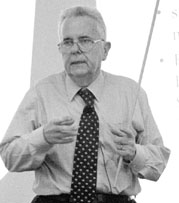 |
|
Hyperons At The Crossroads by Mike Perricone New results, new capabilities for precision measurements and questions about future directions: Hyperons are particles at a crossroads."What is the message we want to send to Fermilab and to the whole high-energy physics community in terms of accelerators and experimental programs?" asked Emmanuel Monnier of the University of Chicago, co-chairman with Fermilab's Doug Jensen of the Hyperon '99 conference held at Fermilab from September 27 to September 29, attracting 65 participants from 11 countries. "What are we going to do in 10 years?" Monnier continued. "And what about the mid-term interval? The best result of this conference will be to have everyone convinced of the increasing value of this physics." Like neutrons and protons, hyperons belong to the baryon family made up of three quarks. But hyperons are distinguished by having at least one strange quark in their three-quark makeup. They decay by the weak force with a lifetime of about 10-10 seconds. The source of concern surrounding this three-quark challenge is the expected phase-out of the 800 GeV fixed target run of the Tevatron in January 2000, as the Lab continues preparations for Collider Run II. As Vincent J. Smith of the University of Bristol pointed out, there were hopes among the participants that the conference wouldn't represent a forum for "what should have been done, and won't be done now." Hyperon physicists declare that a high-energy beam such as the Tevatron's is a highly effective way to get the numbers of particles for the precision measurements they need. And in fact, the Tevatron is currently running in an unofficial "hyperon mode." "From the beginning of this laboratory's history, Fermilab has been engaged in hyperon physics," said Fermilab Deputy Director Ken Stanfield in his opening remarks. "As we speak, the last planned 800 GeV fixed target run has two operating experiments, HyperCP and KTeV, both in the hyperon business." HyperCP is searching for CP violation, or asymmetries between matter and antimatter, in hyperon decays, while KTeV is in the hyperon business by coincidence. KTeV (Kaons at the Tevatron) is mainly searching for CP violation in decays of the neutral kaon, a particle consisting of two quarks (one strange quark and one down quark). But hyperonsˇand lots of themˇemerge as by-products of the process producing the kaons. KTeV actually produced a significant hyperon result that Stephen Bright of the University of Chicago presented to the conference. KTeV measured a cascade or X0 hyperon beta decay (a weak decay emitting an electron) almost exactly matching a result predicted in the early 1960s by Nicola Cabibbo, whose contributions include the Cabibbo angle that led to the well-known CKM (Cabibbo-Kobayashi-Masakawa) Matrix critical to the advance of particle physics over the last four decades. Monnier noted that KTeV's direct measurement of CP violation in the neutral kaon system occurred within 35 years of the discovery of CP violation in that system. By comparison, a similar phenomenon with hyperons is still unobserved. And nearly 40 years after the prediction, a hyperon decay similar to the well-known neutron beta decay has just been confirmed. Cabibbo attended the conference and heard the result bearing out his prediction. "It was a neat thing," said Jensen. "Cabibbo presented his paper in 1963. We showed the results he had predicted at this conference. That shows how difficult these experiments are. It took from 1963 until now to produce the results he predicted." The result came to be described as "the last hyperon beta decay" during the conference. While the term referred to a result that filled out the range of predictions, there was also the echo of hyperon physicists' fears of a dead end. But the picture might change quickly. Any evidence of CP violation among the billion decays of the HyperCP experiment would spark additional interest in hyperon experiments. "If HyperCP gets a signal, maybe we'll continue an 800-GeV fixed-target run here," said Fermilab physicist Peter Cooper. "The Lab is keeping that option open." In the long run, the biggest hope for the field appeared to lie in proposals for a 3-TeV accelerator that would serve as a "test machine" for a Very Large Hadron Collider, a possible next-generation successor to the Large Hadron Collider being built at CERN, the European particle physics laboratory in Geneva, Switzerland. Jensen said that very high energy for hyperon decays "makes the puzzle fit together much more easily." The newly-commissioned Main Injector was also described as a very interesting mid-term source of hyperons.
"For a program to be interesting, you must have a core result that continues the progress of knowledge," Cabibbo said. "Is it teaching you something really fundamental? Is it something you can't do any other way? To have a program for the future, the value of the results must increase over time." Cabibbo also gave his own personal "shopping list," including precise studies of this "last hyperon beta decay," as well as the almost unexplored S+ and discovery of hyperon CP violation. "There has been a bubbling of new results, and we now have techniques available for high-precision measurements," Monnier concluded. "We hoped this conference would force people to bubble with ideas a bit." |
| last modified 10/15/1999 email Fermilab |
FRLsDFx9eyfrPXgV
 In his own presentation to the conference, Cabibbo posed the hard questions that researchers must face about their area of focus.
In his own presentation to the conference, Cabibbo posed the hard questions that researchers must face about their area of focus.